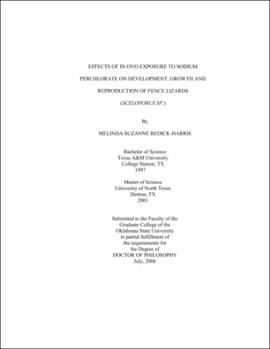| dc.contributor.advisor | Talent, Larry G. | |
| dc.contributor.author | Redick-Harris, Melinda Suzanne | |
| dc.date.accessioned | 2013-11-26T08:28:24Z | |
| dc.date.available | 2013-11-26T08:28:24Z | |
| dc.date.issued | 2006-07 | |
| dc.identifier.uri | https://hdl.handle.net/11244/7042 | |
| dc.description.abstract | Scope and Method of Study: This research was designed to determine the effects of long term in ovo perchlorate exposure on eggs, juveniles and adult fence lizards. Reptile eggs are highly extensible and absorb environmental pore water throughout incubation. Perchlorate is a water soluble environmental contaminant that interferes with synthesis of the thyroid hormones, thyroxine (T4) and triiodothyronine (T3) by preventing iodide uptake by the thyroid gland. Decreases in circulating embryonic thyroid hormones may interfere with growth and development of embryos and may have permanent effects. Endpoints measured during incubation included: egg viability, size, oxygen consumption rate, incubation length, and hatchability. Initial size (mass and snout/vent length), thyroid and corticosterone hormone levels, and growth rate were measured in hatchling lizards. Clutch and egg size were recorded as indications of breeding success for adult fence lizards. Adult plasma thyroxine levels were measured in all adults exposed to perchlorate in-ovo and plasma testosterone levels were recorded in males. Eggs for this study were collected from a laboratory population of fence lizards on the day of oviposition and incubated on perchlorate-spiked perlite at a constant temperature of 28°C. | |
| dc.description.abstract | Findings and Conclusions: Corticosterone and thyroid hormones appear to play a significant role in the hatching of western fence lizards. Perchlorate absorbed from spiked substrate caused decreased whole body thyroid hormone concentrations at concentrations greater than 15.8 ug ClO4-/g. Throughout incubation eggs exposed to 1,585 ug ClO4-/g and higher consumed less oxygen than control lizards. Furthermore, incubation length in ovo mortality and post hatch mortality increase in a dose dependant manner when perchlorate was present in the incubation substrate. Eastern and western fence lizards that survived post hatch appeared to completely recover from embryonic perchlorate exposure. Eastern but not western fence lizards grew more rapidly than control lizards and eastern females outperformed control lizards with regard to clutch production. Adult serum hormone levels were not different in control and perchlorate exposed lizards. | |
| dc.format | application/pdf | |
| dc.language | en_US | |
| dc.rights | Copyright is held by the author who has granted the Oklahoma State University Library the non-exclusive right to share this material in its institutional repository. Contact Digital Library Services at lib-dls@okstate.edu or 405-744-9161 for the permission policy on the use, reproduction or distribution of this material. | |
| dc.title | Effects of in ovo exposure to sodium perchlorate on development, growth and reproduction of fence lizards (Sceloporus sp.) | |
| dc.contributor.committeeMember | Janz, David M. | |
| dc.contributor.committeeMember | Bidwell, Joseph R. | |
| dc.contributor.committeeMember | McBee, Karen | |
| osu.filename | Redick-Harris_okstate_0664D_1988.pdf | |
| osu.accesstype | Open Access | |
| dc.type.genre | Dissertation | |
| dc.type.material | Text | |
| thesis.degree.discipline | Zoology | |
| thesis.degree.grantor | Oklahoma State University | |
